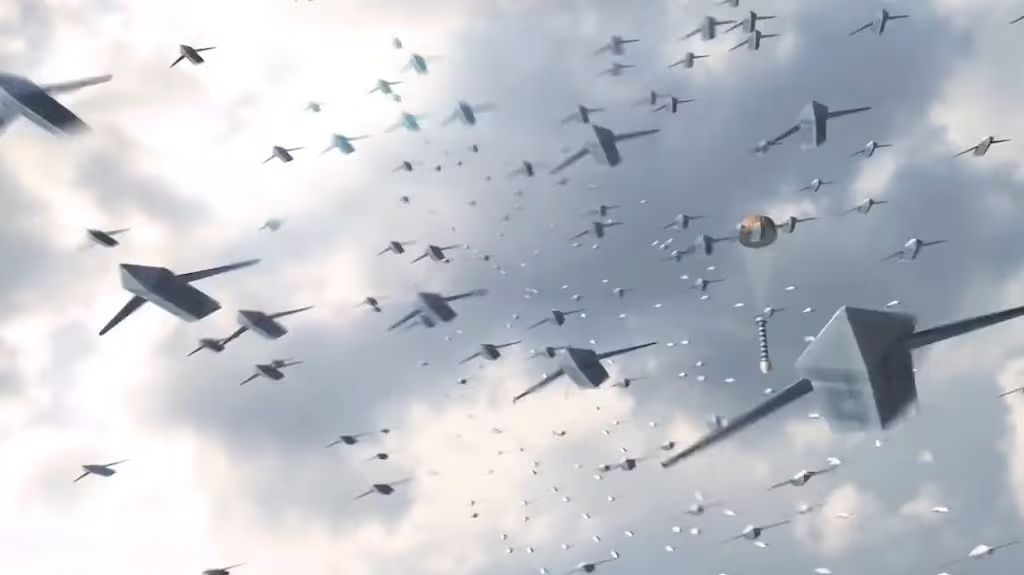Stealth was once the privilege of state-of-the-art fighter jets and high-altitude reconnaissance aircraft. Today, the same principles of radar evasion are being applied to far smaller, more numerous, and more agile platforms: drones. But what makes these platforms especially dangerous is not their individual sophistication—it’s their collective behavior.Modern drone warfare is entering a new phase. Rather than sending one advanced vehicle, adversaries are beginning to deploy swarms: tens or even hundreds of small, hard-to-detect drones working together in a coordinated pattern. They are difficult to see, difficult to stop, and increasingly central to next-generation battlefield tactics.
Why Drones Swarm
Drone swarms are not just a matter of quantity. Their real power lies in strategy. A single drone may be easy to neutralize. A swarm, by contrast, can saturate airspace, overwhelm defenses, and create ambiguity about what the real threat is. Some drones act as decoys, others as jammers, and still others as strike units—all launched simultaneously and often with pre-programmed, adaptive behavior.
Swarming mimics the logic of biological systems: birds, insects, and fish use group behavior to confuse predators and improve survival. Military drone swarms follow the same logic. They move in fluid formations, split apart, reconverge, and behave in ways that challenge radar systems designed to detect conventional aircraft flying solo.
The Stealth Factor
What makes the threat even more complex is the low radar cross section (RCS) of these drones. Many are made of composite materials, have compact shapes, and are designed to fly at low altitude—all of which makes them extremely difficult to detect using traditional radar systems.
Individually, their RCS may fall below detection thresholds. Together, they blend into what looks like clutter or noise. And when they initiate electronic countermeasures—such as coordinated jamming, terrain masking, or exploiting gaps in radar coverage—they can behave like a shadow army, visible only after it’s too late.

Image - Source: Air Force Research Laboratory
Confusion Is a Weapon
The strategic value of a stealth drone swarm lies not only in its destructive potential, but in its ability to confuse decision-makers. Is this a real attack? Is this a diversion? Are we looking at a jammer, a camera, or an explosive?
Swarm tactics turn radar ambiguity into a tactical advantage. Defense systems may fire at non-lethal decoys and leave the true strike drones untouched. Human operators may hesitate to respond for fear of collateral damage, especially in urban or civilian areas. And even advanced AI-supported radar systems can struggle to identify swarm signatures buried in low signal-to-noise environments.
Radar Must Evolve
Traditional radar was not built for this. Most systems rely on detecting singular objects with relatively high RCS values. Their logic is based on filtering out what seems irrelevant: weather, birds, terrain reflections. But drone swarms live in that gray zone. Their weak, irregular, and fluctuating returns make them look like background noise.
To face this new challenge, radar must evolve. It must be capable of tracking multiple weak signals simultaneously, interpreting patterns of movement, and distinguishing between natural clutter and coordinated threat behavior.
SkyRadar’s Stealth Detection III: Built for Swarms
SkyRadar anticipated this shift. That’s why the third module of its Stealth Detection suite is entirely focused on swarm and complex target analysis. Designed as part of the SkySim and FreeScopes simulation environment, this module trains learners to detect, interpret, and counter stealth drone swarms under realistic conditions.
The system simulates swarms of 10 to 30 drones, flying clustered or dispersed patterns. Operators use micro-Doppler analysis to detect rotor activity invisible to conventional tracking. They apply track-before-detect (TBD) techniques that integrate weak returns over time to reveal consistent movement patterns. And a convolutional neural network (CNN) assists in classifying swarm signatures versus harmless clutter.
Learners discover how to adjust scan intervals, optimize Doppler filters, and combine time-series analysis with spatial reasoning. Each exercise reinforces the importance of looking beyond the obvious, of seeing what was once invisible.
Practical Learning in a Safe Environment
What makes SkyRadar’s approach so effective is its realism without risk. All target profiles are synthetic, designed to simulate real-world behavior without drawing on classified data. Yet they behave just as a real swarm would—fluctuating, fragmenting, reuniting, and jamming during their simulated approach.
Students can engage in repeatable exercises. Instructors can inject specific threat behaviors. And AI-enhanced tools help reinforce not just what to detect, but how to interpret what’s being seen.
Training the Human Mind Behind the Radar
While AI and automation play an increasing role in radar technology, the final decisions still rest with human operators. It is the person behind the screen who must assess: is this a threat, a test, a malfunction, or a distraction?
SkyRadar’s stealth swarm detection module is not just about machine vision. It is about training human judgment—giving students the experience and instinct to make fast, accurate decisions in the face of uncertainty.
This is the kind of radar training modern defense and security operations demand. Not just signal interpretation, but threat interpretation.
Preparing for What Comes Next
Stealth drone swarms are no longer the stuff of science fiction. They are being tested, deployed, and refined around the world. The tactics are evolving. The technology is advancing. And the ability to detect and respond must evolve with it.
SkyRadar’s Stealth Detection III module ensures that radar education stays one step ahead. By simulating swarm behavior, teaching advanced detection techniques, and preparing learners for cognitive and technical challenges, it gives today’s students the tools they’ll need tomorrow.
Because the future of air defense will not be fought against lone aircraft. It will be fought against algorithms, against decoys, against networks of silent machines. And they will not come alone. They will come in swarms.
Let's talk
Stay tuned to be always the first to learn about new use cases and training solutions.
Or simply talk to us to discuss your project.




